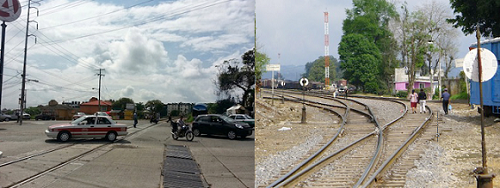Español | English
Once the main transportation network, many cities in the US were formed around railroad tracks. Nowadays, what was once a sign of economic prosperity has become out of place in a growing city. Many railways now serve as passageways for occasional freight movement or have been abandoned completely. The result? A cut right through the city with negative consequences for the safety and mobility of its residents.
Xalapa, Veracruz, Mexico (Photos by Ivelisse Justiniano & Roland Krebs)
During a recent visit to Campeche and Xalapa, Mexico – two cities recently integrated in the Emerging and Sustainable Cities Initiative (ESCI) – I observed examples of this firsthand.
In Campeche, I was surprised to see the railway tracks running along a major street, right in the front yards of the bordering homes. When I saw the track conditions I assumed the train was no longer in operation and that the tracks were still there because it is too much work to remove them. When our guide saw the look on my face he told me that the train still runs through those tracks despite their poor condition.
There is no buffer zone or barrier to separate the trains from the surrounding buildings, drivers and pedestrians. How can this be? And, what about the safety of these families and their homes? That’s when my Campechano friend confirmed that these freight trains have indeed derailed, causing serious accidents. Various efforts have been made to relocate the rail lines to a more isolated area that would better protect the safety of Campeche’s residents.
Derailment of trains in Campeche, Mexico (Photo courtesy of Campeche.com.mx)
In Xalapa it was a similar situation in some areas. Here the railway also runs through the center of the city, making intercity commutes longer as people have to cross or go around the rail tracks to travel between the communities the track divides. Although the railway has a buffer zone around it in some locations, many intersections lack signaling to control car and pedestrian traffic and in order to prevent accidents between them and oncoming trains. In practice these tracks are more often traveled by pedestrians than by the freight trains it was designed to service.
In both cases, use of the railways is irregular and they do little to benefit the city since the trains are just used for sporadic freight transfers. These old railways divide the city, hurting mobility by making commutes longer. This affects, to a lesser extent, the environment by increasing air pollution and more significantly, public safety. Noticing the many people walking along the rail tracks I wondered whether it could be possible to divert the train traffic to another area and then use the railroad’s path as a corridor to connect the cities’ currently separated communities. A type of green corridor for pedestrians and cyclists.
In researching the issue, I found several examples of railways that have been relocated to address security, land use and mobility issues. These efforts usually involve redirecting traffic to new area on the edges of the city or infrastructure improvements that consolidate the multiple tracks through urban areas or move them out of the way of traffic.
Many of these projects have been carried out through public-private partnerships between state or city agencies and railroad company partners. In the US, for example, a double track main line once cut through the city of Reno, Nevada’s highly-congested downtown area dividing the city in half and threatening the safety of its citizens. However, through a collaborative project between the City of Reno and Union Pacific Railroad the rail was lowered to eliminate the barrier and as a result improve traffic circulation through the downtown area.
Centro Urbano de la Ciudad de Reno antes de la Reubicación Ferrovial (arriba) y Zanja de Reubicación del Tren (abajo) (Fotos por S. Varela)
In Lafayette, Indiana, the city worked with multiple federal and state agencies to consolidate and relocate the railways to a corridor along the outskirts of the city. Taking over 29 years to complete, the project was in response to safety and traffic problems associated with the trains and in anticipation of continued growth of the urban population.
Like all large infrastructure projects there are always advantages and disadvantages. Many stakeholders have to be involved in railroad relocation, including local government, private sector and citizens. Although the duration and cost is extensive, I think that the positive impact is just as significant, since not only do these types of projects benefit the community “affected” by the railway, they also benefit the railway company by improving operations and transit times for their trains.
But what do you think: is it time to take the train out of the town?





Leave a Reply